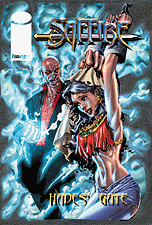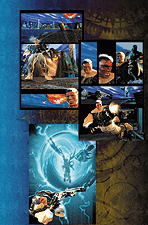Think those feature film software packages don't apply to comic book production? Think again. Joseph Szadkowski reveals the amazing meshing of production tools that is happening across many media.
Both amateur and professional artists have explored the computer as a creative tool. The creation of CAD (Computer Aided Design) software allows architects, engineers and 3D artists to visualize and manipulate the objects or spatial environment they are designing. Moreover, the program allows artists to skew virtual reality, realistic rendering, 3D and behavioral modeling elements to impact the perception of designs ranging from architectural blueprints to animation cels. The ability to create computer graphics and effects has changed the advertising, art, design and multimedia industry. Digitally created and enhanced images have altered the art gallery. Even on the newsstand we see evidence of how computers have affected the pictures we see, the words we read. Computers have changed our pop art as well, modifying the course of animation early on and more recently affecting the creation of another visual art form, the comic book.

It's Not NewShatter (June, 1985) was the first computer-generated comic book. Published by First Comics, Inc., it was created by Mike Seanz and Peter Gillis initially, with Charlie Athanas taking the artistic reins from issue 8 until its conclusion. "The artwork was created from the ground up on a MacPlus with 1MB of RAM and a couple of 3.5 floppy drives," states Charlie Athanas, artist and President Burning City, Inc., on his Web site (http://burningcity.com). "The pages were created in black and white, printed and then colored in the traditional manner. It was not until the last couple of issues that I was able to get a stylus and tablet. Prior to that, it was 28 pages of artwork, every two months, using a mouse to draw with."
A few years later, Pepe Moreno's Batman: Digital Justice was at the forefront of the movement to combine the art of comic books with computer technology. Created in 1990 using a Macintosh II, the book was created with the help of 3D modeling, Raster and Vector painting and drawing programs, page layout and story telling. The system it was produced on was an 8 bit/32 bit color board, a system palette of 16,000,000 possible colors, 8MB of RAM, a removable 45 MB hard disk drive and a Trinitron monitor.

"When I decided to pursue doing digital comic books, Batman Digital Justice is the book that stood out," says Mat Broome, artist and owner of Digital Broome Studios, San Diego (www.digitalbroome.com). "Not only did other efforts not include vector graphics, but there are so many dark tones to the book that gave it weight. I was amazed at what the artist, Pepe Moreno, could do then and I wonder what he would do with the technology we now have. There is some pretty amazing stuff out there."
A Way of Business
In today's computerized world, the machines that Pepe Moreno and Charlie Athanas worked on are akin to a fossil in a museum. Today's more powerful computers are not only stepping in with comics production but artists are working with sophisticated animation and modeling tools to draw both characters and backgrounds. This new digital artist is tasked with not only knowing how to draw, but also the ins and outs of digital technology.
Mat Broome worked with Jim Lee's Wildstorm studios in 1994 when he expressed an interest in learning the skills and acquiring the equipment in order to incorporate three-dimensional modeling tools into comic book creation. "Unfortunately they did not see the importance of it," explains Broome. "So I left and went to school on my own."

He saved money earned -- generating over three million comics sold annually for publishers like Marvel Entertainment, DC Comics, Image, Dark Horse and Acclaim -- and invested in the equipment and two years of schooling he needed. "I took all the money I had saved and invested in training and a license to work with Maya 2.5, a program used by Hollywood studios in the creation of animated feature films," he explains.
That investment totaled in the neighborhood of US$40,000, but as technology advances prices drop and today's artist could anticipate an investment of less than $10,000. For this comic artist the investment in training and tools has lead to his own digital art studio. Founded in 1996, the concept was to bridge the gap between two-dimensional illustration and 3D models.
With employees skilled in both the 2D and 3D arts, as well as video game programming, the group is creating more than just comic books. The company has also done television advertisements, movie trailers (including one now appearing for Titan A.E.), DVD custom art and menu creation, Webisodes for dotcoms, a recent Toonami ad campaign for Cartoon Network and even more traditional graphic arts such as a recent logo designed for the RCA recording artist Eve 6. Their client list includes Time Warner, Electronic Arts, Cartoon Network, Turner Broadcasting, MTV and FOX Entertainment.

A New Comic Book"We are working toward being the 'kings' of all art media," says Broome. "But, if we bridge the gap of taking comic book art digital it would be huge. But you need more than great programmers that know 3D. You need artists with a strong 2D background behind the machines because it is the only way to provide high-caliber models and maintain consistency with the conceptual sketches."
Toward that goal, Digital Broome has created their first digital book Saffire. In its creation, Broome applied 3D textures onto 2D art giving the textures and artwork more dimension, leading to increased visual weight and depth. "For the foreground elements, we have the 2D image and go into 3D and create bump maps which are grayscale maps that allow us to apply texture and patterns," he explains. "The finished artwork, though it started as a 2D image, has a very real, three-dimensional look to it."
Examples of other technology in use on the comic book page are the bubbles escaping from divers in an underwater scene. "If you look at the bubbles, they were created in 3D but we have touched them up using Photoshop," Broome says. "The end result is that when everything is extremely composited as a photo, it is hard to tell what began as 2D, 3D or linear making the images stronger and the visual story that much more compelling."

The Human Touch
New to the industry, CrossGen Comics of Tampa, Florida (www.crossgen.com) still favors the hand drawn image but relies on computers for everything from lettering to coloring to printing. "The penciler's hands are the last to touch our comic pages," said Brandon Peterson, art director CrossGen Comics. "More and more we are scanning in the pencils and using the computer to add the inking. All pages are colored using Photoshop and the lettering is done using Illustrator. We then compile the pages using Page Maker and it is then sent 'straight to plate' for printing." (The term "straight to plate" refers to the comic page being printed from the computer image, maintaining a first generation look to the printed page.) Peterson clarifies by adding, "From the time the first pencil drawing is scanned in, it stays digital to the plate, eliminating the step of going to film."


CrossGen is trying to add some new fire to the comic book look. © CrossGen Comics. CrossGen titles are holding on to the art, while using new technology as a way to bring it to life. © CrossGen Comics.
For both Digital Broome Studios and CrossGen Comics, the art begins with pencil to paper, but each are applying the computer in different ways to create different effects, however it is making an impact. With the help of computers, lettering takes a day, effects not capable using pen and ink are accomplished with a few mouse clicks and finished pages, instead of being rushed to the printer, are sent in a flash over e-mail.
"We believe that the comic book needs to begin with the hand drawn image because though the technology exists to create the models I feel it takes longer and that it loses what I call the 'happy mistake,'" says Peterson. "Those mistakes are when the texture of the paper shows through, or the thin wispiness of faded ink, arms that are not perfect matches or a crooked smile that appears. Hand drawn people allow for the real world imperfections that we all have and I feel it is a livelier line that the fan responds positively to."
Joseph Szadkowski writes on various aspects of popular culture and is a columnist for The Washington Times.







